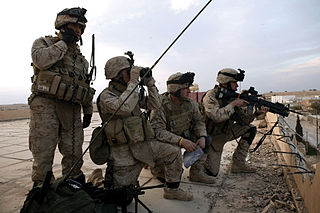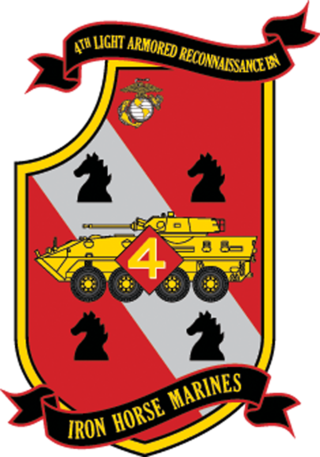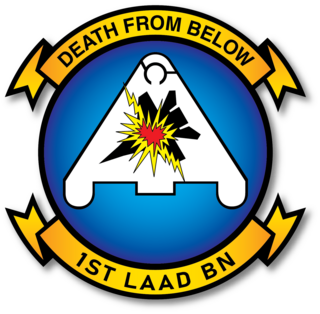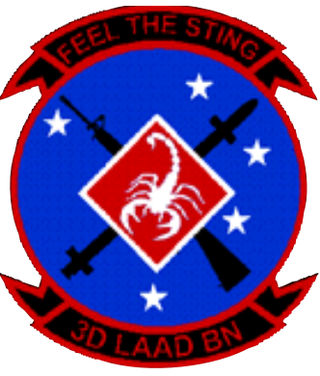Combat service support is a topic that is, broadly speaking, a subset of military logistics. However, combat service support is often more limited in depth, as the related groups primarily address factors supporting readiness for combat operations. The United States Department of Defense organizes various agencies providing services such as medical assistance, for example, akin to other nations' militaries.

Air Naval Gunfire Liaison Company (ANGLICO) is an airborne fire support and liaison unit of the United States Marine Corps. The mission of ANGLICO is "To provide Marine Air-Ground Task Force (MAGTF) Commanders a liaison capability to plan, coordinate, and conduct terminal control of fires in support of joint, allied, and coalition forces. Per this mission statement, ANGLICOs are not designed to support U.S. Marine Corps maneuver elements. Instead, the doctrinal purpose of ANGLICO is to provide fire support and coordination in support of units adjacent to the MAGTF.

2nd Light Armored Reconnaissance Battalion is a fast and mobilized armored terrestrial reconnaissance battalion of the United States Marine Corps. Their primary weapon system is the 8-wheeled LAV-25 and they fall under the command of the 2nd Marine Division and II Marine Expeditionary Force. The unit is based out of the Marine Corps Base Camp Lejeune, North Carolina. The current mission statement of the battalion is: To perform combined arms reconnaissance and security missions in support of the Ground Combat Element (GCE) of a Marine Air-Ground Task Force (MAGTF). Its mission is to conduct reconnaissance, security and economy of force operations, and, within its capabilities, limited offensive or defensive operations that exploit the unit's mobility and firepower.

2d Battalion, 2d Marines (2/2) is a light infantry battalion in the United States Marine Corps based out of Marine Corps Base Camp Lejeune, North Carolina. Also known as "The Warlords", it consists of approximately 1,000 marines and sailors and normally falls under the command of the 2d Marine Regiment and the 2d Marine Division.
In the United States Marine Corps, a Marine Air–Ground Task Force is the principal organization for all missions across the range of military operations. MAGTFs are a balanced air–ground, combined arms task organization of Marine Corps forces under a single commander that is structured to accomplish a specific mission. The MAGTF was formalized by the publishing of Marine Corps Order 3120.3 in December 1963, "The Marine Corps in the National Defense, MCDP 1-0". It stated:
A Marine air–ground task force with separate air ground headquarters is normally formed for combat operations and training exercises in which substantial combat forces of both Marine aviation and Marine ground units are included in the task organization of participating Marine forces.

4th Light Armored Reconnaissance Battalion is a United States Marine Corps Light Armored Reconnaissance battalion of the Marine Corps Reserve. Their primary weapon system is the LAV-25 and they are part of the 4th Marine Division and Marine Forces Reserve. The unit headquarters is at Camp Pendleton, California, but other units in the battalion are located throughout the United States. 4th LAR Bn is the largest combat battalion in the Marine Corps, with 7 companies.

Marine Air Control Group 28 (MACG-28) is a United States Marine Corps aviation command and control unit based at Marine Corps Air Station Cherry Point that is currently composed of four command and control squadrons and a low altitude air defense battalion that provide the 2nd Marine Aircraft Wing with airspace coordination, air control, immediate air support, fires integration, air traffic control (ATC), radar surveillance, aviation combat element (ACE) communications support, and an integrated ACE command post in support of the II Marine Expeditionary Force.

Marine Unmanned Aerial Vehicle Training Squadron 2 (VMUT-2) is an unmanned aerial vehicle training squadron in the United States Marine Corps that is transitioning from operating the RQ-21A Blackjack to the MQ-9A Reaper. The squadron is based at Marine Corps Air Station Cherry Point in Havelock, North Carolina and will serve as the MQ-9A Reaper Fleet Replacement Squadron, training UAS officers and enlisted sensor operators. Historically, VMUT-2 provided aerial surveillance, offensive air support, and electronic warfare for the II Marine Expeditionary Force. VMUT-2 falls under the command of Marine Aircraft Group 14 and the 2nd Marine Aircraft Wing.

The 1st Low Altitude Air Defense Battalion is an air defense unit of the United States Marine Corps. It is part of Marine Air Control Group 18 (MACG-18) and the 1st Marine Aircraft Wing and is based at Marine Corps Air Station Kaneohe Bay, Hawaii. The battery was decommissioned on 28 September 2007 and reactivated on 31 August 2023.

The 3d Low Altitude Air Defense Battalion is an air defense unit of the United States Marine Corps currently responsible for providing short range air defense. The battalion falls under the command of Marine Air Control Group 38 (MACG-38) and the 3rd Marine Aircraft Wing and is currently based at Marine Corps Base Camp Pendleton, California.

4th Low Altitude Air Defense Battalion was a reserve air defense unit of the United States Marine Corps. They were part of Marine Air Control Group 48 (MACG-48) and the 4th Marine Aircraft Wing and were based out in Pasadena, California.

The United States Marine Corps is organized within the Department of the Navy, which is led by the Secretary of the Navy (SECNAV). The most senior Marine commissioned officer is the Commandant of the Marine Corps, responsible for organizing, recruiting, training, and equipping the Marine Corps so that it is ready for operation under the command of the unified combatant commanders. The Marine Corps is organized into four principal subdivisions: Headquarters Marine Corps, the Operating Forces, the Supporting Establishment, and the Marine Forces Reserve.

Combat Logistics Battalion 2 (CLB-2) is a logistics unit of the United States Marine Corps (USMC), which provides direct combat service support to Regimental Combat Team 2 (RCT-2). CLB-2 was formed after its second deployment to Iraq in 2005 as a part of the reorganization of the 2nd Force Service Support Group. The battalion falls under Combat Logistics Regiment 2 and the 2nd Marine Logistics Group and is headquartered at Marine Corps Base Camp Lejeune, North Carolina in the USA.
In the United States Marine Corps, the ground combat element (GCE) is the land force of a Marine Air-Ground Task Force (MAGTF). It provides power projection and force for the MAGTF.

The 2nd Marine Expeditionary Brigade is a brigade of the United States Marine Corps. It is part of II Marine Expeditionary Force. It advertises itself as a "middleweight" crises response force of choice in the European and Southern Command Areas of Operation. It is able to "operate independently, as a service component, or to lead a Joint Task Force". Self-sufficient and interoperable, the 2nd Marine Expeditionary Brigade possesses a mix of command and control, combat power and specialized logistics. Operating as part of the greater Marine Corps team and with support from the United States Navy and other services, it can provide operational reach.
In the United States Marine Corps, the aviation combat element or air combat element (ACE) is the aviation component of the Marine Air-Ground Task Force (MAGTF). The ACE is task organized to perform the six functions of Marine Corps aviation in support of MAGTF operations. The ACE is led by an aviation headquarters which employs rotary-wing, tiltrotor, and fixed-wing aircraft in conjunction with command and control, maintenance and engineering units.

8th Communication Battalion is a communications battalion in the United States Marine Corps. It is part of the II Marine Expeditionary Force and is headquartered at Marine Corps Base Camp Lejeune, North Carolina.

The History of ground based air defense in the United States Marine Corps dates back to the early 1930s with the establishment of the Advanced Base Force. World War II would be the high-water mark for air defense units when 20+ defense/anti-aircraft battalions were formed with many seeing significant action throughout the Pacific Theater. Following the war, the Marine Corps divested itself of most of its air defense capability at a time when the service was facing deep personnel cuts and fighting for its institutional survival. Beginning in the early 1950s the Marine Corps aligned itself with the Navy and their development of surface-to-air missiles (SAMs). The Marine Corps retained both flak weapons and SAMs throughout the 1950s until the fielding of the MIM-23 Hawk Missile System in 1960. The HAWK Missile was employed by Light Antiaircraft Missile (LAAM) battalions and remained a mainstay of Marine Corps ground based air defense for the next four decades.
The Marine Air Command and Control System (MACCS) is the aviation command and control agencies of the United States Marine Corps that provide the Aviation Combat Element (ACE) commander with the means to monitor, supervise, and influence aviation operations in support of the Marine Air-Ground Task Force. The command and control agencies of the MACCS are provided by the squadrons and battalions of the Marine Air Control Groups that are present within each Marine Air Wing. The capabilities resident within the MACCS allow the MAGTF commander to safely conduct aviation operations, facilitate timely maneuver and prosecution of fires and ultimately retain full control of their entire area of operations. MACCS agencies are also responsible for coordinating Marine Corps aviation operations with joint, multinational and civil aviation.

















